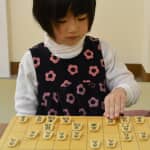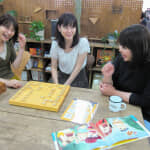Shogi 26 March 2017
Let’s Compare Shogi with Other Board Games ~Geister~
Shogi is a representative of Japanese board games.
We would like to start a series of “Let’s compare Shogi with other board games” to remind the charm and depth of Shogi. We ask for your kind understanding that we are not a professional board game critic.
So, the first game to commemorate this series is “Geister.”

Each player tries to transport his/her good ghosts to the opponent’s camp capturing good ghosts (blue) and evil ghosts (red) mutually. Occasionally, a player lets the opponent capture ghosts on purpose. The rules are fairly simple and a game does not take too long. Even young children can fully enjoy this game.
1. Basic data
- Name: Geister
- Number of players: Two
- Target age: Eight years old and above (Children a little younger than eight can also enjoy as far as they understand the rules.)
- The time required: 10 to 20 minutes
Rules
- Each player has four red ghosts and four blue ghosts.
- Each player arbitrarily sets up eight ghosts on the first two rows of his/her own camp excluding the squares on the both right and left ends. The red ghosts are evil and the blue ghosts are good.
- Two players take turns to move one of his/her ghosts. (Both good and evil ghosts can move one square in any direction but diagonally.)
- To win, a player must move one of his/her good ghosts off the board from one of the opponent’s corner squares, capture all of the opponent’s good ghosts, or get rid of all of his/her own evil ghosts.

2. Common features between Shogi and Geister
- Players move a piece alternately.
- Players capture pieces.
- There are phases in a game.
Similar rules, similar strategies
I think that Geister is quite similar to Shogi among many board games.
Since its rules are close to those of Shogi, its strategies also look like Shogi’s.
For instance, there are opening, middle and last phases during a game in both Shogi and Geister.
The opening phase in Geister is a situation where ghosts are set up and start attacking.
Unlike Shogi, however, players can set up pieces’ initial positions by their own choice in Geister.
In this sense, you may feel that Geister is a little different from Shogi. However, players in Shogi can create their own battle formation by moving Hisha (Rook), pushing a castle or so forth after starting game as well. Considering the above, players create their own piece formations to prepare for battles in both Geister and Shogi.
Also, it is disadvantage that many pieces, whether they are good or evil, are captured immediately after opening a game in Geister as well as Shogi. Therefore, to avoid such a numerical disadvantage, each player strings his/her ghosts from the beginning so that he/she can recapture them even when they are captured once.
Probably in the opening phase, both players put forward evil ghosts. Therefore, while capturing the opponent’s evil ghosts, players try to develop to the middle phase. Players figure out the timing to generate numerical advantage by occupying the edge squares, move good ghosts forward, or do not capture the opponent’s ghost even when the ghosts collide.
If you lose good ghosts by the middle phase, for example, you are in a relatively disadvantageous situation. This situation in Geister may be similar to the time when your opponent cleverly captures your Gin (Silver) and Kei (Knight) that you use for offense in Shogi.
Finally, you pursue a situation whereby the opponent cannot help capturing your evil ghosts with edge attack. Or, you win by tactics and let your good ghost go off the board through one of the opponent’s corners.
Considering the above, to win a game in Geister, it is important to adopt Shogi-like approach and strategies such as piece-building, stringing, number-based attack, edge attack and push-sacrifice.
Differences between Shogi and Geister
Complete information game versus incomplete information game
The rule of reusable pieces is not applicable
Differences on reading
It is very important to read the opponent’s thought for both Shogi and Geister. However, there is slight difference between the two. Shogi is a complete information game which means all of your information is open to your opponent. On the other hand, Geister is an incomplete information game in which you cannot see whether the opponent’s ghost is good or evil by its appearance.
Unlike Shogi, you can adopt a strategy of intentionally letting the opponent capture your ghost for a game of Geister. For example, you can take a tactics that you let the opponent capture several evil ghosts of yours first, and then, bargain with the opponent.
When your opponent moves a ghost as if he tries to get rid of it, usually, the ghost is probably evil.
However, that is just your estimation. You need to reveal the opponent’s true intention hidden behind his/her move.
Originally, it is disadvantage to have fewer pieces than the opponent in Geister. Nevertheless, if you let the opponent capture a couple of evil pieces at first, then the opponent feels like “I do not want any more evil ghosts.”
Furthermore, if the opponent captures three evil ghosts of yours, then he/she feels hesitated to capture another piece of yours despite the fact that it looks very suspicious. Taking advantage of this situation, you can protect your good ghosts and capture many of the opponent’s good pieces.
So, we have discussed “Geister” today. How was it? Since it contains many elements of Shogi, I think that Shogi fans can feel familiarized with it and enjoy it.
If your child has not started Shogi yet, then you can use Geister as a starter. Or if your child already know about Shogi, then you can use Geister as a tool for change of air.
We hope you will enjoy Shogi furthermore through playing various board games.
If you are interested in learning Shogi, check out our articles on Shogi rules!




